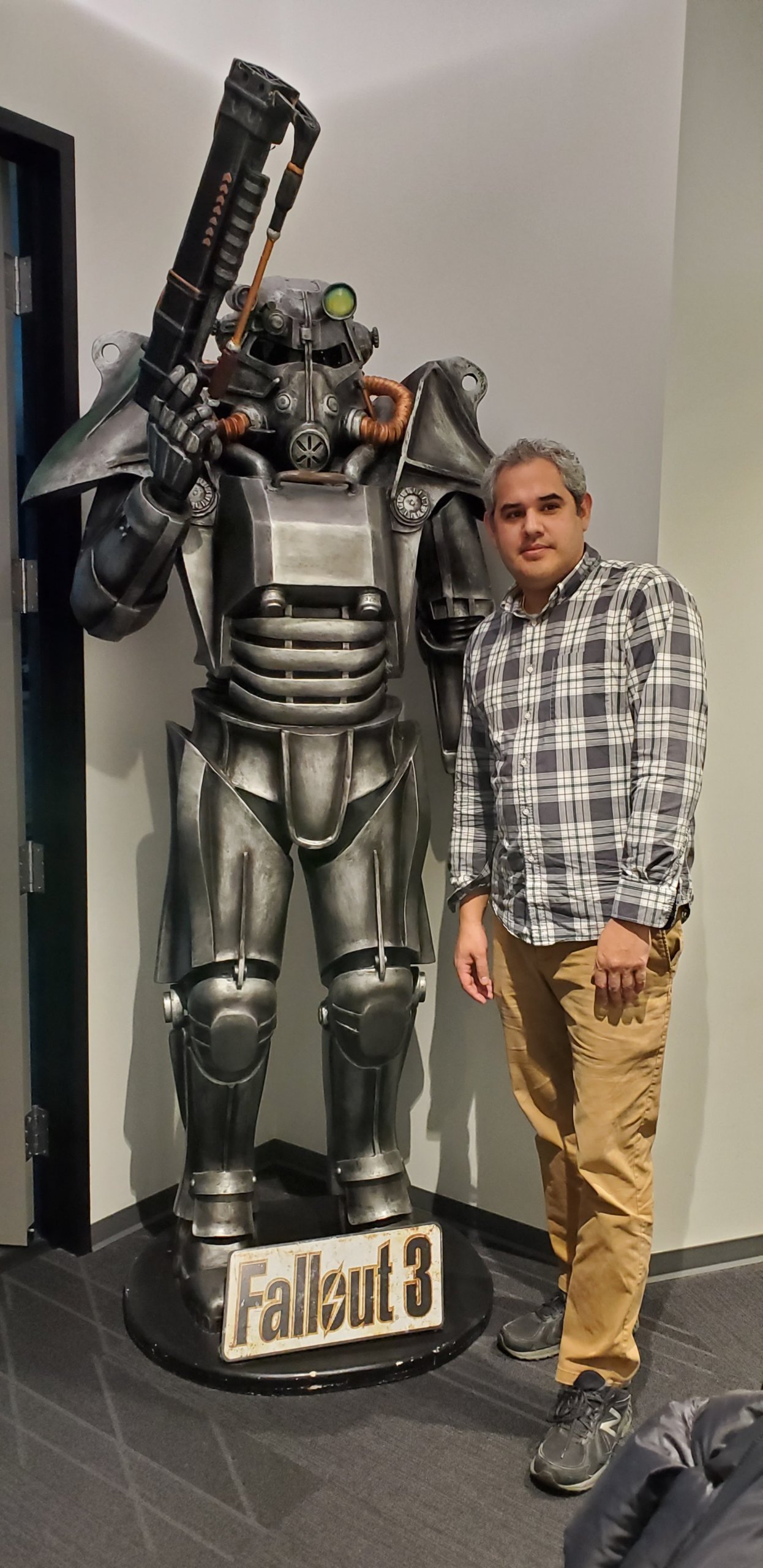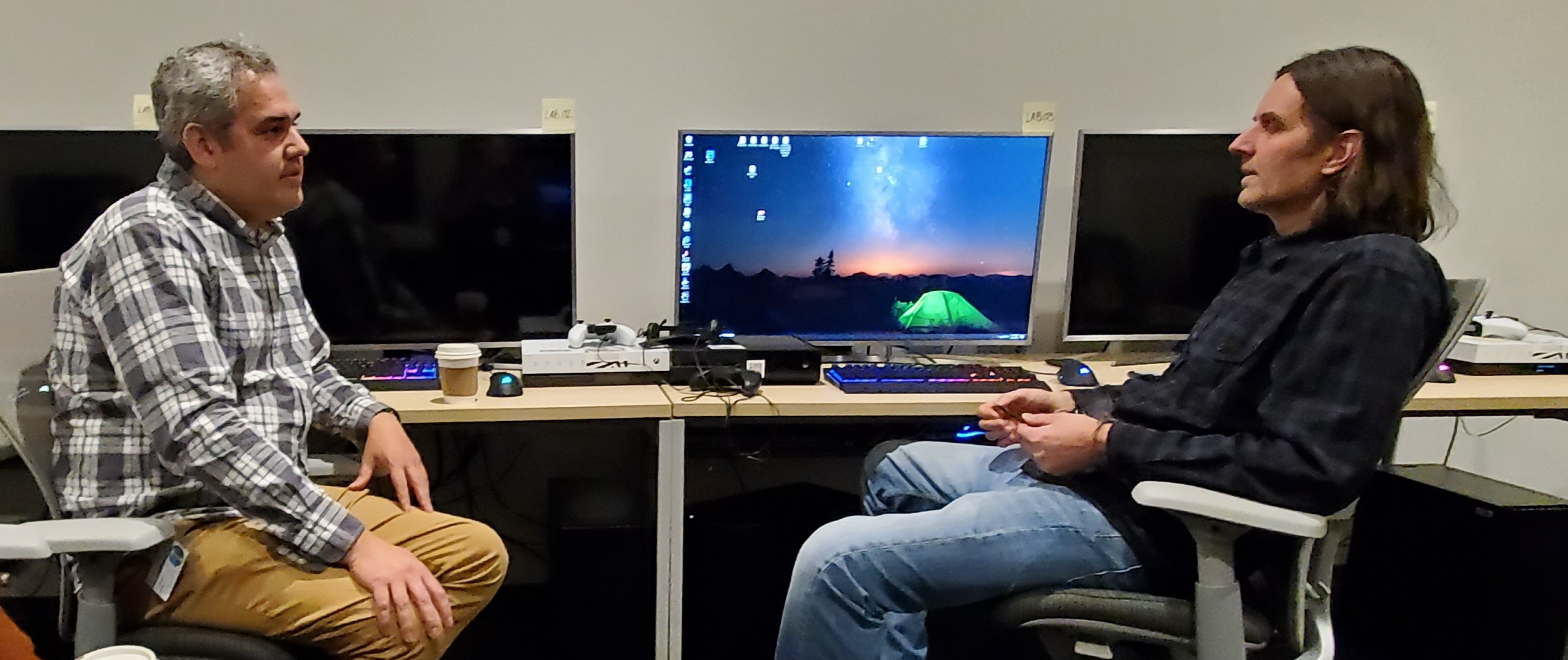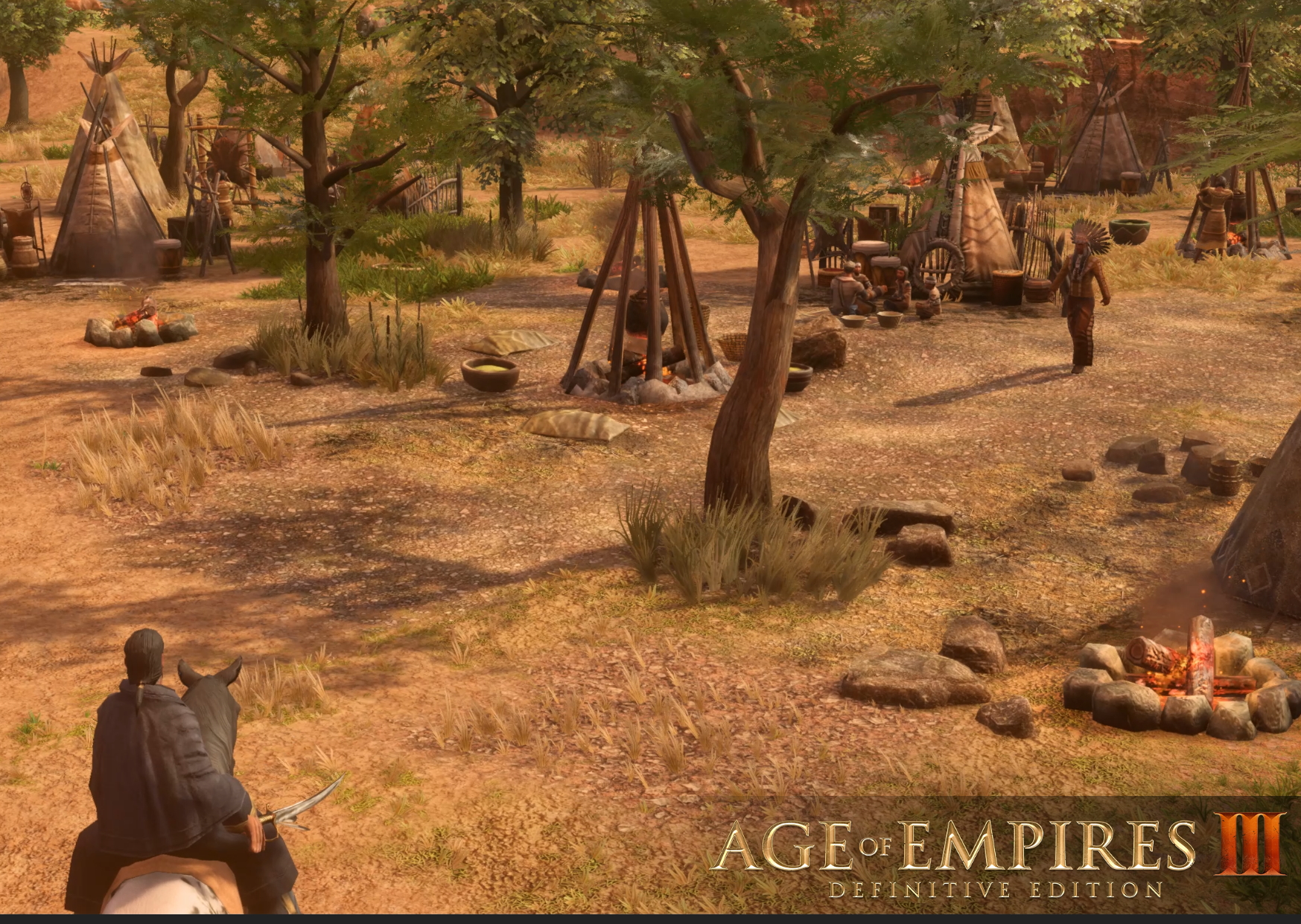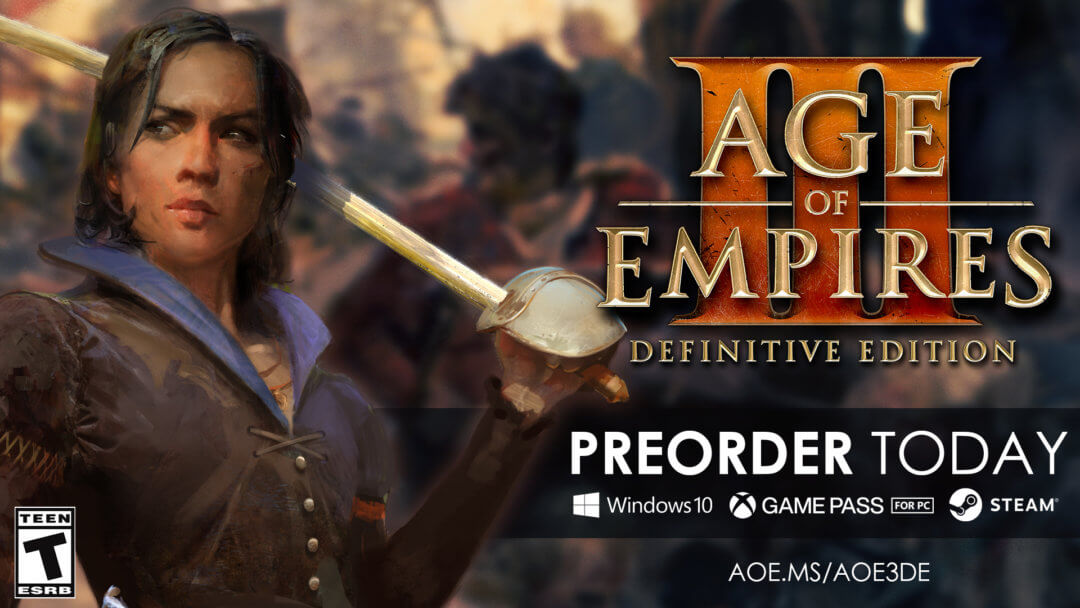
Anthony at the Xbox Headquarters in Redmond
As we get ready to launch Age of Empires III: Definitive Edition on October 15th, we’ll be diving deep into the development process to highlight the changes and updates that make it a truly definitive version of the game.
One area that’s seen a notable evolution from the original is the way we represent the Native American and First Nations civilizations. A key focus of our work at World’s Edge is to authentically represent the cultures and peoples that we depict in our games. In creating Age III: DE, we realized that we weren’t upholding that value as well as we could regarding the Indigenous North American cultures represented. So we set out to fix that: working directly with tribal consultants to respectfully and accurately capture the uniqueness of their peoples, history, and cultures. Returning players will find there’s been some changes to the Native American and First Nations civilizations, and we hope you find them as compelling as we do!
To give you some insight into the changes, why they were made, and how we worked with our tribal consultants, we’ll be sharing interviews with the individuals that helped guide us throughout the process. Our first piece is a discussion with Anthony Brave; we hope you enjoy getting to know Anthony and learning more about the work we did together.
♦ ♦ ♦
WORLD’S EDGE: A huge World’s Edge welcome to Anthony Brave—a Sicangu Oyate (Rosebud Sioux Tribe) and Chippewa-Cree descendant. Anthony was our lead cultural expert for the Indigenous peoples portrayed in Age of Empires III: Definitive Edition. He was also the writer of the new Shadow storyline (Act II of The War Chiefs). Thank you so much for spending more time with us!
WORLD’S EDGE: Could you please talk about the work you did with the Age of Empires team?
ANTHONY BRAVE: Sure. As a cultural consultant, I reviewed and then reported on Age III with attention to its depictions of Native American and Indigenous peoples. As for the writing, the request came as a surprise to me…but with a little encouragement, I decided to take the opportunity to change the narrative. It ended up being a lot of fun and a great learning experience too.
WORLD’S EDGE: We had fun too, and we learned a lot. Let’s dive straight into one of the biggest alterations in the DE based on feedback from our consultants: the name changes for the Sioux and Iroquois civs. Before we started working on the DE with our Native American and First Nations consultants, we didn’t know that the names Sioux and Iroquois were given to them by European settlers; so we have changed those civ names in the DE to their Indigenous names—Lakota (Sioux) and Haudenosaunee (Iroquois).
WORLD’S EDGE: Could you tell us what the word, Lakota, means, and why you still use the term “Sioux” in your bio?
ANTHONY BRAVE: We are Lakota, broadly, and Lakota people are historically made of up seven nations. One of those nations is Sicangu Oyate, which I belong to.
To oversimplify things, Sicangu Oyate eventually settled in a reservation called the “Rosebud Sioux Reservation.” Turns out the pejorative term, “Sioux,”* stuck and got bureaucratized in the treaty process. So, when I say I’m a Rosebud Sioux Tribal member, this is in reference to my official political status as a member of the Tribe. A bio is more of an official thing; when not doing the official thing, I prefer Sicangu Oyate, or simply Lakota.
* [Note: The name Sioux was first used by a rival tribe, and means “snakes.”]
WORLD’S EDGE: How did you come to work with World’s Edge?
ANTHONY BRAVE: Super randomly, actually. It was two summers ago in my role directing our annual summer Native youth camp (NY’EHE) at Washington State University. I had a meeting with our cultural advisors about how we could improve the camp while reviewing the draft of the schedule I came up with (even Native folks need Native advisors). I had put a video game-making workshop into the schedule, and after going over the workshop, one of our advisors from the Nimiipuu (Nez Perce Tribe), Josiah Pinkham, spoke on how important it was to have good Native representation in video games. He went on to share his story of how he worked with the team that rebooted Killer Instinct to improve Thunder and create Eagle. I immediately switched from being anxious that the advisors would approve the idea of a video game workshop to asking if he’d like to tell his story to the youth.
Long story short, it ended up being even better than I could have imagined as a camp planner: where Thomas tátlo Gregory (Nimiipuu/Nez Perce Language Team Leader) and Laura Hamilton (Global Readiness Manager, Xbox) gave a fantastic presentation to the Native youth before the workshop.
WORLD’S EDGE: You’re a hardcore gamer. What are your favorite games of all time?
ANTHONY BRAVE: HARDCORE TO THE MEGA!
Jokes aside, I have played a lot of games in my time…but what a tough question! I love playing Gears with my wife, Kate. Now that I think about it, many of my favorite gaming memories have been when games brought me closer to the people I care about: whether it was playing rummy with my grandma in Montana, playing chess with my step-dad, learning how to get through the World 3 dungeon in the original Super Mario Bros. with my older sister, or playing fighting games—like KI—with my best buds in the arcades. I now play Warzone—if only to chat with one of my best friends—as a more recent example.

The young gamer, Anthony
Although it is certainly not everything to a game, representation means a great deal to me: not just on an intellectual level, but on an emotional level. Playing full-on Indigenous-made games like Elizabeth LaPenseé’s 2D adventure game, When Rivers Were Trails, gives me the chance to see myself and my people in a good way—which up until this point has been a rare case in video games.
WORLD’S EDGE: What was it about Elizabeth LaPenseé’s game that resonated with you as a person with Indigenous heritage?
ANTHONY BRAVE: There’s a lot of things. For starters, it is a space that allows players to react in Native ways. There are points in the game where you must make choices in how you handle a given situation, but one of the differences in this game is there are Native options to choose from as reactions to situations. For example, you can pull out a hand-drum and sing or offer tobacco in reaction to a situation, which I’ve never seen in any other game I’ve played up until this point.
Then there’s the sheer diversity of Native people you meet along your journey. Apparently there were around 30 other Native writers from a variety of Tribes as a part of the project—bringing their stories into the game. At first I thought it was cool—like on an intellectual level—but after hours of play and meeting Native people in a video game, something happened; I felt overwhelmed with a joyful feeling. At that moment, I realized I hadn’t played a video game made by and for Natives. I guess I had been wishing for something like this for a long time, but hadn’t fully realized it until that moment happened.
WORLD’S EDGE: Your work has been so valuable to our storytelling and representation of Lakota people. What were some of the most important changes you requested in Age of Empires III: Definitive Edition?
ANTHONY BRAVE: To be honest: there were times playing the game as a Lakota guy—as me—that felt pretty cringey. For example, the Fire Pit is pretty bad—not to mention the skulls on spikes at, like, all Indigenous villages in the main game. The mining was just nonsensical for Native people, too.
WORLD’S EDGE: Could you explain why having Indigenous North Americans mining made you feel that way? You’re not the only Native American or First Nations consultant who pointed that out to us.
ANTHONY BRAVE: Mining is pretty antithetical to Native values in general. We are taught to respect the land as our mother and be in good relations with it. Mining is a form of exploitation of the land, and we would never treat our mother like that.
WORLD’S EDGE: We ended up changing the Mining mechanic to the Tribal Marketplace, which allows for an alternative method to gather Coin. We then worked with top players in an early closed beta environment to ensure that it’s still fun and balanced. You mentioned the Fire Pit game mechanic too. What was it about the Fire Pit that was offensive and/or hurtful to Indigenous Peoples?
ANTHONY BRAVE: Although I don’t think the original creators intended it this way, the Fire Pit was pretty offensive…for a number of reasons. It hit me as soon as I saw it, and immediately brought to my mind these old stereotypes of Natives dancing around the fire like wild savages. Upon contact, Native people weren’t considered human by their western counterparts—but as wild animals without souls. If anything was wild, however, it was the imagination of colonists; we all had robust societies, cultures, governing structures, languages, histories, etc., and certainly weren’t wild or savage.
The Fire Pit works magically in that having people dance around a fire somehow gives warriors on the battlefield more power. On the other hand, the Western people get power through logical means: like the development of technology or increasing their capacity for war by developing their forts. This perpetuates the old, tired “savage vs civilized” dichotomy.
It’s also like, for all Indigenous people, there is the Fire Pit: like a one-size-fits-all thing, which just doesn’t work given how different we all are as Indigenous peoples.
Having something like the Fire Pit be so central to the game’s play continues to reinforce these rather pernicious notions about us. With its presence, it subtly says, “it’s okay to utilize these kinds of images of Native people.” Unless we change these kinds of representations—big or small—in a way, we will all be stuck dancing around a Fire Pit.

Anthony meets with Age of Empires Narrative Director Noble Smith to discuss Age III: Definitive Edition in the World’s Edge QA lab
WORLD’S EDGE: Based on the feedback we got from you and other consultants, we changed the Fire Pit to the Community Plaza (a building where Villagers work together to create benefits for your civilization) and went through the same beta process to balance this.
WORLD’S EDGE: We also removed the “Nature Friendship” ability from the Native American and First Nations civs in the game. Can you explain why this was an important and necessary change?
ANTHONY BRAVE: This trope seems particularly prevalent in video games to the point where it seems like if there is a Native character in a video game, that character must have animal powers. When it gets that entrenched, it would be good to stop the dancing around that pit as well.
WORLD’S EDGE: Just so our readers know, the removal of Nature Friendship has also been adjusted in the game with alternative abilities that have also been through the same balance testing as the other adjustments.
WORLD’S EDGE: Now, let’s talk about Crazy Horse—who means a lot to you. Who was he? Why was he such an important figure in the history of this country?
ANTHONY BRAVE: First off, when I saw Crazy Horse, I was also like “Who’s this Iron-Eyes Cody looking Crazy Horse?!” I had a hard time following the story, at times, because every time I saw Crazy Horse I was so perplexed. There were no known photos taken of Crazy Horse, although there are oral descriptions of him…and this was nothing like I had imagined.
Iron-Eyes Cody (for those who don’t know) was this Sicilian guy who masqueraded in Hollywood as a Native American. He was cast as the Native guy in a now infamous commercial from the 70’s with the tear going down his cheek after someone threw trash at him…which is actually hilarious if you think about it.
Crazy Horse was an issue for me: not just in the way he looked, but the fact that he seemed to be appropriated just to spice up a “Native” storyline. Crazy Horse being this great Lakota leader was a hero of mine growing up—as closely as I can say I had any heroes—and his role in the original Shadow storyline trivializes who he really was.
WORLD’S EDGE: And so when you saw him portrayed in the game, you felt like a game was not an appropriate place for a revered personage like him?
ANTHONY BRAVE: I think a game can have Crazy Horse in it, but it has to be done right: with great care, thought, and research from the beginning…not just in how he is represented, but also with the kind of context the game creates. In this case, it just didn’t seem very dignifying for someone of his standing. I would also add that if you wanted to depict Crazy Horse, you should reach out to his maternal family to get permission.
WORLD’S EDGE: You rewrote the Shadow storyline. Could you explain what was problematic about the original story and what changes you made to the plot?
ANTHONY BRAVE: The main things I wanted was to have Chayton be more relatable and to offer another kind of mentor for him in the form of his uncle…who is an intentionally fictional, but bit more rounded-out character.
The original story wrote Chayton as a Native guy who wasn’t really Native. He knew nothing about Lakota culture, history, or his family; on top of that he was just incredibly naïve—to the degree that he was somehow shocked there was trouble between Native folks and settlers. Like, what timeline are you living in, bro?
WORLD’S EDGE: We love the new version of Chayton, and also your creation of the Lakota elder, Uncle Warbonnet (aka Uncle Frank), to replace Crazy Horse. Could you talk about Uncle Frank and what he means to you?
ANTHONY BRAVE: Uncle Warbonnet is Chayton’s Uncle. We kept the fact that Chayton’s father was Lakota. I wanted to lean into that. I wanted Chayton to have a mentor figure who had a natural connection to him. In Lakota culture, it’s not uncommon for an uncle to take care of his nieces or nephews if their father is unable to do so. This being the case, I decided to create a new character—which was Uncle “Frank” Warbonnet—in replacement of Crazy Horse.
Folks might wonder what’s up with naming him Frank. The history is that many native folks were “given” missionary names back in those days, which were obviously not their traditional names. Given this history, I took the opportunity to put a little ironic humor into it and flip things around; for a people who have been misnamed as “Indians” for over 500 years, it’s hard not to have a sense of humor about these things.

Chayton meeting with his Uncle Warbonnet (aka Uncle Frank)
WORLD’S EDGE: What elements of the story change—if any—resonated strongly or personally with you?
ANTHONY BRAVE: I like the buffalo (bison) theme…which kept coming up in my mind when I was writing. To me, they are a symbol of strength and resilience. They also don’t hesitate to teach someone a lesson if that person gets too close. 😊
WORLD’S EDGE: If our players are interested to learn more about the Lakota people and the breadth of Native American people and cultures, what further resources would you recommend to them?
ANTHONY BRAVE: My advice: if you want to get to know someone or a community, it’s about building good relations—which, as we know, can take a whole lot of time, energy, and care. And like all relationships, there aren’t any guarantees.
It’s hard to really do justice to the incredible diversity and dynamism of Native and Indigenous peoples, but I’m happy to give a couple recommendations:
One is a podcast called “All My Relations,” which (at this time) is in its second season. It’s great for Native and non-Native folks alike. It’s not only filled with tons of laughter and love, but is a great crash course on the contemporary issues Native communities and people are facing. I highly recommend it.
If you want to dig into representation a bit more, give the documentary out there called Reel Injun a watch; it’s not hard to find.
WORLD’S EDGE: We’ve found working with Native American consultants to be incredibly educational and we’re so thankful for your help and support. We hope that this improved representation will inspire and educate others as it has us. Are there any examples of media that better represent Native American peoples and cultures that you could recommend our players seek out?
ANTHONY BRAVE: It’s the media made by and with Indigenous folks that do the best job with representation. For a start, go play When Rivers Were Trails, Thunderbird Strike, Umurangi Generation, Terra Nova, and Never Alone. If you want a contemporary book to read, check out Tommy Orange’s book,There There, or Heart Berries by Therise Mailhot. For the movie buffs out there, I would suggest The Fast Runner, Powwow Highway, and Smoke Signals is still a good one.
There’s really so much out there, way more than these suggestions…
WORLD’S EDGE: Is there anything you’d like to communicate directly to people who’ll be playing our changed and new Native American and First Nations content in Age of Empires III: Definitive Edition?
ANTHONY BRAVE: The entire team put an incredible effort into improving this game. I hope you enjoy it…especially the Lakota parts. 😊
♦ ♦ ♦
Another huge thanks to Anthony Brave for joining us! Watch for more interviews with Age of Empires III: Definitive Edition Native American and First Nations consultants in the weeks to come, and be sure to pre-order Age of Empires III: Definitive Edition to check out all of the changes for yourself this October!
